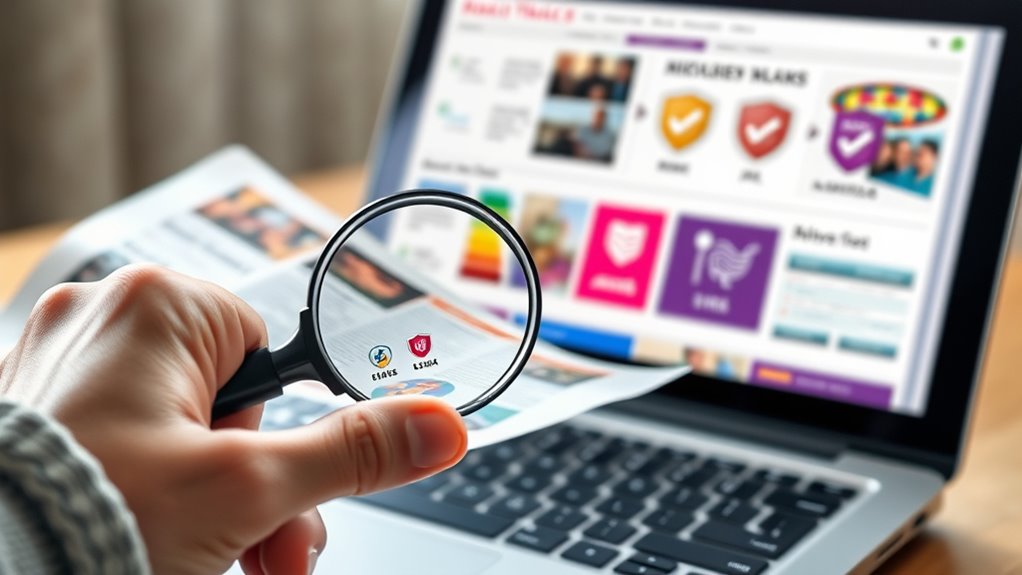To debunk misinformation effectively, start by recognizing your own biases and questioning your initial beliefs. Develop strong critical thinking skills by evaluating sources for credibility and supporting evidence. Cross-check information using reputable fact-checking sites and multiple reliable outlets to confirm claims. Be aware of manipulation tactics like sensational headlines and false visuals. Staying curious and reflective helps you separate truth from fiction. Continue exploring these strategies to become more skilled at spotting and countering misinformation.
Key Takeaways
- Cross-check claims using reputable fact-checking sources and multiple reliable outlets.
- Question the credibility and methodology behind information before accepting or sharing it.
- Recognize common misinformation tactics like sensational headlines or manipulated visuals.
- Remain aware of personal biases to prevent distorted perception of facts.
- Encourage critical thinking by asking logical questions and seeking diverse perspectives.

Have you ever wondered how to tell fact from fiction in today’s digital landscape? With misinformation spreading rapidly across social media and news outlets, it’s more important than ever to develop strategies to identify and debunk false claims. The key lies in understanding psychological biases that influence how you interpret information and honing your critical thinking skills to evaluate sources objectively.
Psychological biases, like confirmation bias, cause you to favor information that aligns with your existing beliefs, making it easy to accept falsehoods that support your worldview. To counteract this, you need to actively challenge your assumptions and seek out diverse perspectives. Recognize when your emotions or preconceived notions are clouding your judgment, and try to approach claims with an open mind. This awareness is the first step toward minimizing bias and making more rational decisions.
Challenge your assumptions and seek diverse perspectives to reduce bias and make more rational decisions.
Critical thinking plays a essential role in this process. Instead of accepting information at face value, ask yourself questions: Who is the source? What evidence supports this claim? Is there a logical explanation? Are reputable experts backing this up? Developing a habit of questioning and analyzing claims helps you separate credible facts from misleading misinformation. Remember, reputable sources often cite evidence and provide transparent methodology, so always look for supporting data rather than sensational headlines.
Another effective tactic is cross-checking information across multiple reliable sources. If a piece of news seems extraordinary, verify it through fact-checking websites or established news outlets. Beware of echo chambers where you only encounter information that reinforces your beliefs; diversify your sources to get a fuller picture. This practice not only helps you spot inaccuracies but also broadens your understanding of the topic.
Being skeptical doesn’t mean doubting everything but rather approaching information with a healthy dose of curiosity and scrutiny. When you encounter a startling claim, pause and reflect before sharing or acting on it. Educate yourself about common misinformation tactics, such as sensational headlines or manipulated images, so you can recognize them when they appear. Staying informed about the psychological biases that distort perception gives you an advantage in resisting manipulation.
In essence, debunking misinformation effectively requires a combination of understanding your own cognitive biases and sharpening your critical thinking skills. By questioning sources, seeking evidence, and staying open to new information, you empower yourself to discern truth from fiction. This proactive approach not only protects you from falling for falsehoods but also helps foster a more informed and rational approach to consuming information in today’s complex digital world. Recognizing the importance of color accuracy and other technological factors in media can further enhance your ability to evaluate visual misinformation and deceptive content.
Frequently Asked Questions
How Can I Identify Misinformation Before It Spreads?
You can identify misinformation early by applying fact-checking techniques and sharpening your critical thinking skills. Always verify information through reputable sources, cross-check facts, and question the source’s credibility. Be cautious of sensational headlines and look for evidence supporting claims. By actively analyzing content and practicing skepticism, you prevent false information from spreading, ensuring you stay well-informed and help others do the same.
What Psychological Factors Make People Believe False Information?
Think of your mind as a garden where false info can take root. Cognitive biases, like confirmation bias, cause you to favor info that matches your beliefs, while belief perseverance keeps you clinging to false ideas despite evidence. These psychological factors make it easy to accept misinformation because they reinforce what you already think. Recognizing these tendencies helps you question your assumptions and resist false narratives, keeping your mental garden healthy.
Are There Quick Methods to Correct Misinformation in Conversations?
Yes, you can quickly correct misinformation by using fact-checking techniques like referencing credible sources and providing clear evidence. Trust building strategies, such as listening actively and showing empathy, help make your corrections more effective. When you calmly present accurate information and validate the other person’s feelings, they’re more likely to accept the correction. Stay patient and respectful, ensuring your communication fosters understanding rather than defensiveness.
How Does Social Media Influence the Spread of Misinformation?
Social media influences the spread of misinformation through viral trends, making false info seem popular and credible. Misinformation algorithms prioritize engaging content, often amplifying misleading posts over accurate ones. When you see viral trends, be cautious, as they can spread misinformation quickly. You can help by questioning the source, cross-checking facts, and avoiding sharing unverified content, thereby reducing the impact of misinformation algorithms and slowing its spread.
Can Misinformation Ever Be Fully Eradicated From Society?
Misinformation can’t be fully eradicated from society because media literacy varies and cognitive biases influence how people process info. You can help by promoting critical thinking and encouraging fact-checking. When people understand how biases like confirmation bias work, they become less susceptible. While complete eradication isn’t possible, fostering awareness and education markedly reduces misinformation’s impact, empowering you and others to discern truth from falsehood effectively.
Conclusion
By staying calm, checking facts, and providing clear evidence, you can effectively debunk misinformation. For example, if someone claims vaccines cause illnesses, point out reputable studies showing they’re safe and effective. Remember, your calm and facts can change minds. When you approach misinformation with confidence and kindness, you help create a more informed community. Keep practicing these steps, and you’ll become a powerful voice against false information.









